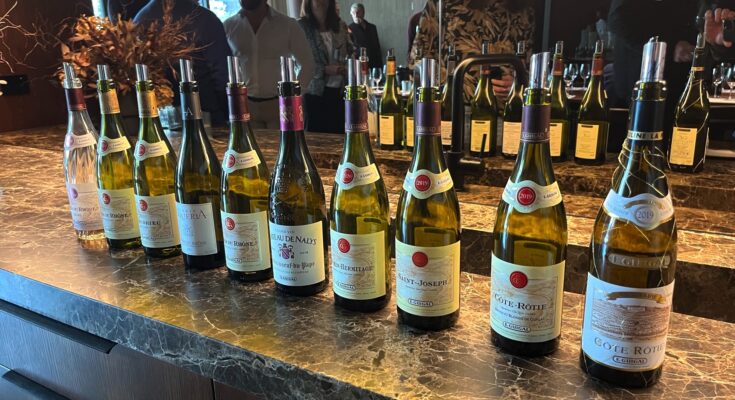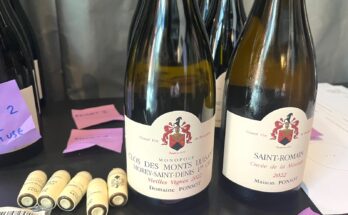A relative newcomer in Old World wine production terms – the domain having been established by Etienne Guigal in Ampuis in 1946. Their home is at the heart of Côte-Rôtie where vineyards and wine have been cultivated for over 2400 years. Much more recently, Guigal acquired the Château de Nalys in Châteauneuf-du-Pape, to solidify a foothold in the southern Rhône – in 2017. The Southern Rhône is an area in which they have traditionally selected grapes from growers (and distinctly not from the co-operatives) with the best sites. It is reckoned that the restaurants of Lyon will sell an average of 750 bottles of Guigal Côtes-du-Rhône Rouge every day!
I’m familiar with the both ends of the spectrum of their output – from the Côtes-du-Rhône Rouge to the “La La” Côte-Rôtie wines, but there are several wines to taste today, many of them new to me. We start with a Guigal Côtes-du-Rhône Rosé 2020, which seems to be a grenache-led wine, showing a snap of clean, red berry fruits, a nip of red liquorice and bubblegum; and has a lovely bright floral nose. It is, of course, that favourite pale coral pink colour that almost all rosé wines, irrespective of origin, have adopted as a trend. With a medium acidity balanced against a richness of fruits – notably not herbal – it is well-rounded and elegant to the finish.
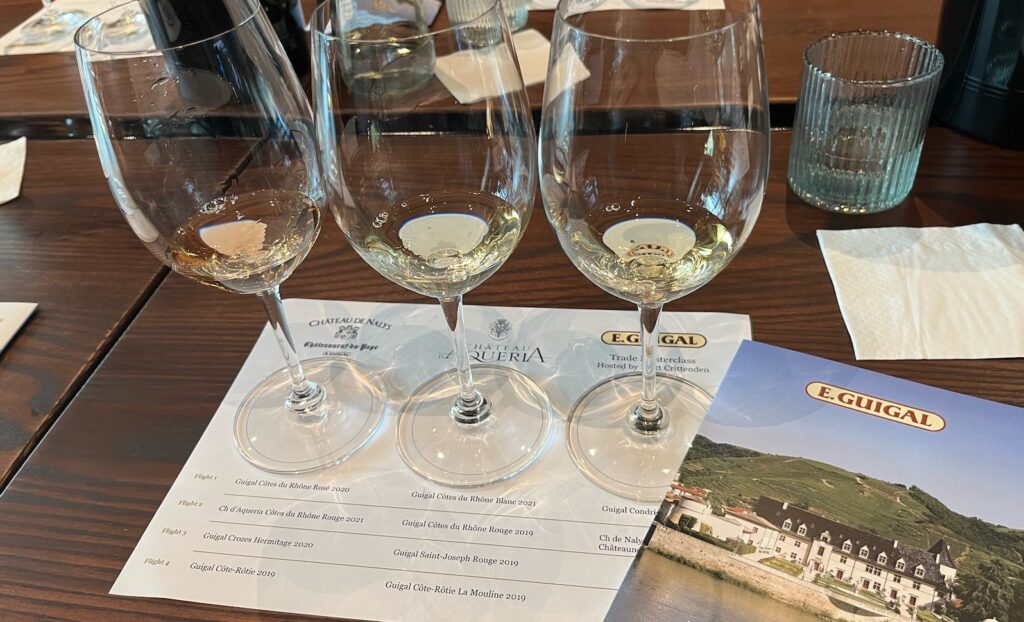
As someone who likes Côtes-du-Rhône Blanc wines, the next two in the flight are a treat to taste. Guigal Côtes-du-Rhône Blanc 2021 shows a classic splay of Viognier typicity, underlined with Roussanne and Marsanne. Again, well-balanced and fruity, with a generous mid-palate and a freshness to the bouquet of almond, white wood, dried peach and musk. A raspy acidity and a touch of green herbals to this one, keeps things agile and buoyant.
Tasting the Guigal Condrieu 2019 is a special moment. Other than the big-sibling wine of Guigal Condrieu La Doriane, you’ll be hard placed to find a better example of Viognier in your glass in New Zealand, or anywhere. When you think of the prices for something like top Burgundy – red and white, and look at the prices being asked for these wines – Condrieu and Côte-Rôtie being the top tier of their field, then you realise that even at the prices for La Mouline and La Doriane, you’re actually getting – comparatively – good value from Guigal’s top wines. And bear in mind that this one of the world’s best-regarded wine brands too.
The nose of the Condrieu starts ripe and rich, contrasting with a flicker of delicate floral notes, and tricks you into thinking you’re about to taste something sweet. The dry, weighty palate takes you by surprise a little. Minerally (assisted by plenty of lees contact) and with a whisper of phenolic, but really plush and fleshy too. It is full-bodied, and you smell the aromas again, and taste again, and it’s confusing. Such finesse and delicacy on one hand, yet unctuous and verdant on the other.
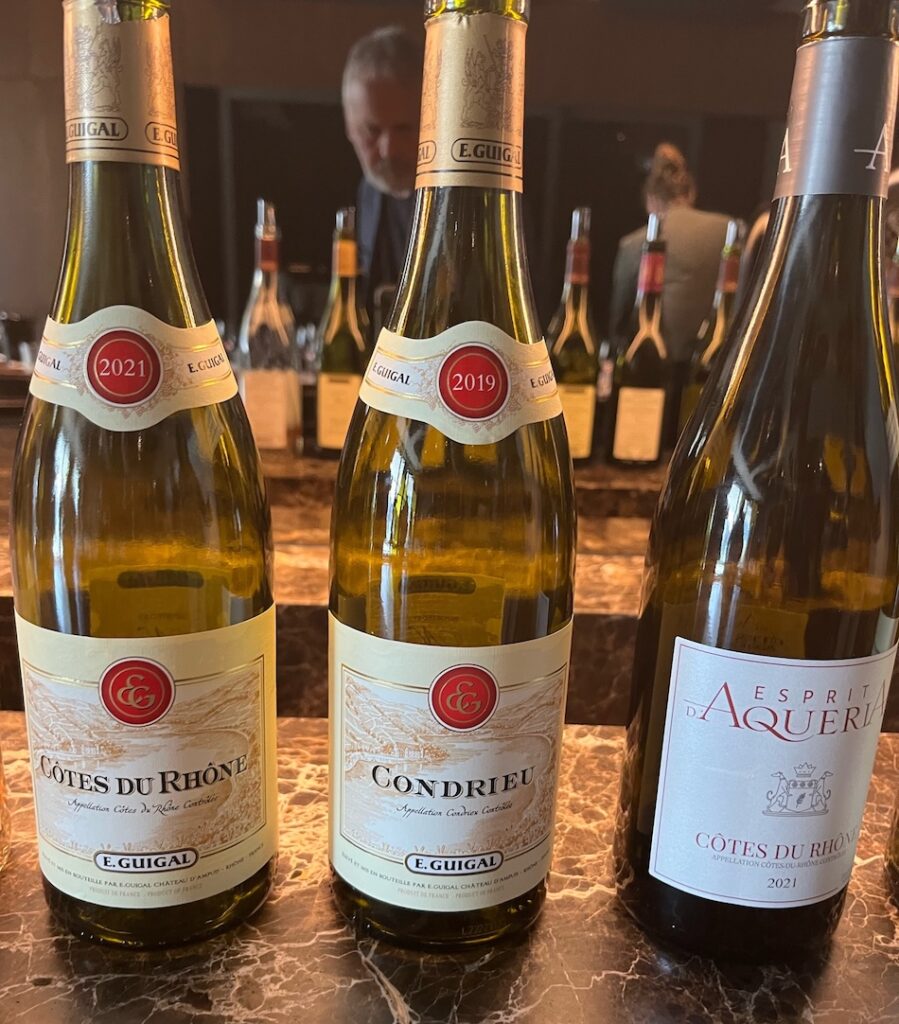
After that delicious drop, we’re onto the reds, and no surprise then that Château d’Aqueria Côtes-du-Rhône Esprit Rouge 2021 comes across as a bit thin – a tough act to follow on from that Viognier. It is a lovely expression of Grenache (I think 90%) – with a crunch of cranberry and raspberry fruits. There’s a sandy, terracotta note through the palate, and it smoothens out towards a decent length of finish. Hands down the more pleasurable wine for me is that Guigal Côtes-du-Rhône Rouge 2019 I mentioned earlier. A brooding but balanced beauty of its type, it starts off with a maypole of intertwining scents and flavours – blood orange, plum, boot polish, redcurrant and roasted spices. So ripe but zesty – it races through the palate. Tannin is well integrated and the oak sits in the background. Around two thirds Grenache of the classic GSM blend. Tremendous wine, superb value.
Château de Nalys Châteauneuf-du-Pape Rouge 2018 sees a step up in price, with the well-recognised appellation adding to the cachet. A powerful but elegant wine, where there are some heroic tannins at play. Structured for the long haul – this is the first of the tasting that will identifiably benefit from cellaring. The acidity is bright, tannin chewy and muscular, and the oak certainly shows. A few edges on show, but with a nice lush line of fruit and already a long finish. Promises well.
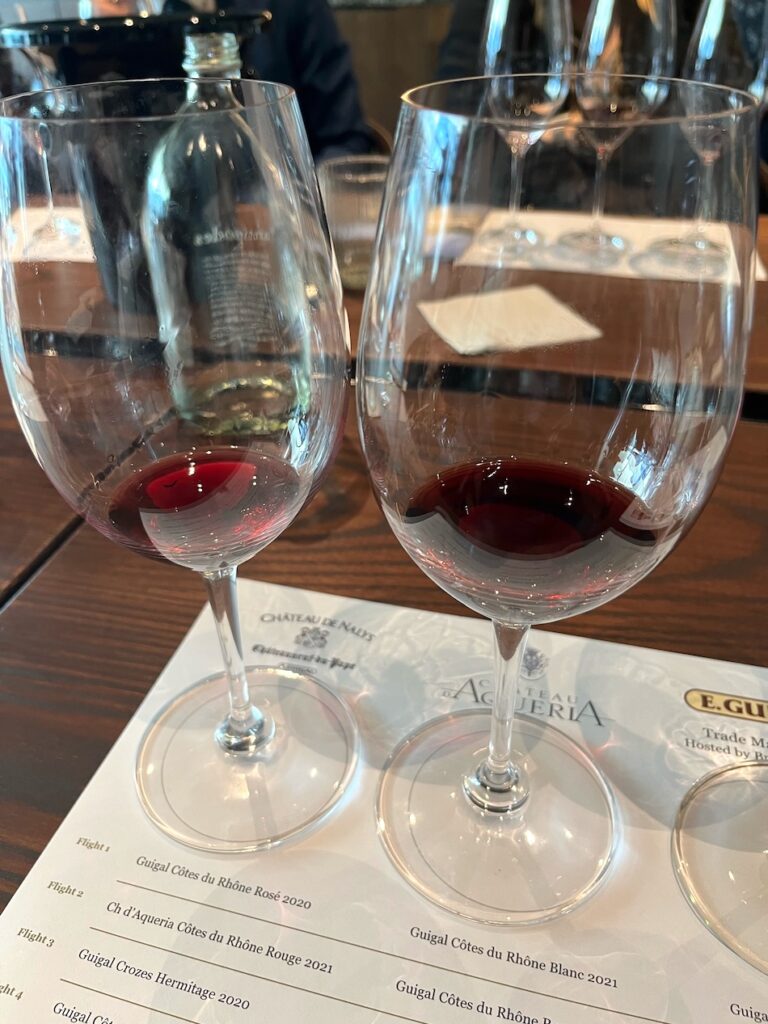
From further north, Guigal Crozes Hermitage Rouge 2019 is showing a slightly astringent nose. I’d stayed away from Crozes Hermitage for a long time due to what I’d perceived to be a thin, greenness to the wines. This is better, but still has that freshness of damson, bitter cherry and herbs. Some spice, vanilla and big tannin, but overall a bit nervy and cutting for me. Different (better?) is Guigal St Joseph Rouge 2019. I’d still go for the ‘half-the-price’ Côtes-du-Rhône Rouge myself, but this wine has a surge of power – plenty of sweet red fruit wrapped around a core of grippy tannin. Also a nice framing of oak to the mouthfilling flavours. A lilting element of violets starts on the nose but filters right into the palate and shows again at the finish.
Anticipation builds for the last two wines as we enter the realm of the Côte-Rôtie wines. The most northerly of the Rhône appellations and rivalled only by Hermitage in reputation. You have to remember that La Landonne, perhaps the best-regarded of the Guigal ‘La La wines’, was only released for the first time in 1978. Whilst it set new standards for the region, this was not that long ago in wine-growing terms. Bolstered and influenced by opinions of international critics such as Robert Parker, the prices and reputations have since sky-rocketed.
Guigal Côte-Rôtie Brune et Blonde 2019 is a pristine ‘estate’ wine, showcasing the appellation very well. A classic expression of what Côte-Rôtie is about. Lightly smoky on the nose, revealing minerality, lilac and violet florals and dark red berry flavours. Beautifully poised with long lines of fine tannin and a dusting of spiced oak. It radiates finesse and controlled power. Guigal Côte-Rôtie La Mouline 2019 is one of the famed single vineyard productions, made in tiny quantities and well-deserving of their place at the pinnacle of Syrah-based wine. Typically 90% Syrah, with 10% Viognier, it sees over three years in new oak. Very rich, complex and intensely perfumed. Mocha, green peppercorn, incense, mulberry, graphite – it’s all there. A pulse of zesty acidity offsets the voluptuous palate, adding energy and vigour. The succulence, tannin and oak working effortlessly in tandem. Confident and attention-grabbing it certainly is, but it is also coherent and quite charming.

